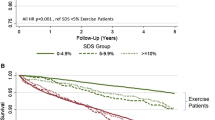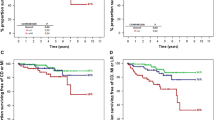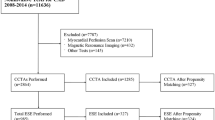Abstract
Objectives
To compare major adverse cardiac event (MACE), downstream resource utilization, and direct cost of care for low-risk chest pain patients observed in the clinical decision unit (CDU) with exercise treadmill testing (ETT) and with stress-only myocardial perfusion imaging (sMPI).
Background
CDUs are poised to increase efficiency and resource utilization. However, the optimal testing strategy that would assure favorable outcomes while decreasing cost is not defined.
Methods
1016 subjects from 2 locations were propensity score-matched (PSM) by age, gender, pre-test likelihood, Duke treadmill score, and test results. Outcomes were length of stay >24 hours, MACE (acute coronary syndrome, revascularization, cardiac death), downstream resource use (admission for chest pain, repeat testing, angiography), and mean direct cost per patient.
Results
PSM yielded 680 patients (340 matches). 98% of all tests were normal. 96.6% of patients were discharged from the CDU within 24 hours but twice as many exceeded 24 hours in the sMPI group. There were no cardiac deaths. MACE rate was 1.47% at 72 hours and 1% at 1 year. Downstream resource use was 4.82% at 72 hours, and 7.69% at 1 year. The sMPI group was event-free longer than the ETT group reflecting less repeat testing. The mean direct cost was 30% higher for sMPI ($3168.70) vs. ETT ($2226.96).
Conclusion
Low-risk chest pain patients in the observation unit had low MACE rate, not different for ETT vs. sMPI. The majority of ETT and sMPI tests were normal. The sMPI reduced additional testing, but resulted in greater expense and longer stay.


Similar content being viewed by others
Abbreviations
- ACO:
-
Accountable care organization
- CDU:
-
Clinical decision unit
- CVD:
-
Cardiovascular disease
- DTS:
-
Duke treadmill score
- ETT:
-
Exercise treadmill test
- MACE:
-
Major adverse cardiac event
- MPI:
-
Myocardial perfusion imaging
- PSM:
-
Propensity score matching
- sMPI:
-
Stress-only myocardial perfusion imaging
- TIMI:
-
Thrombolysis in myocardial infarction
References
Peacock WFCC, Dadkhah S, Sharain K. Short stay management of chest pain. In: Frank PW, Cannon CP, editors. Epidemiology and demography of coronary artery disease. Totowa: Humana Press; 2009.
Heidenreich PA, Trogdon JG, Khavjou OA, Butler J, Dracup K, Ezekowitz MD, et al. Forecasting the future of cardiovascular disease in the United States: A policy statement from the American Heart Association. Circulation 2011;123:933-44.
Jones A, Dwyer LL, Bercovitz AR, Stahan GW The. The National Nursing Home Survey. 2004 overview. Vital Health Stat 2009;13:1-155.
Centers for Disease Control and Prevention. National Center for Health Statisctics. National Hospital Ambulatory Medical Care Survey; 2008.
Tatum JL, Jesse RL, Kontos MC, Nicholson CS, Schmidt KL, Roberts CS, et al. Comprehensive strategy for the evaluation and triage of the chest pain patient. Ann Emerg Med 1997;29:116-25.
Pope JH, Aufderheide TP, Ruthazer R, Woolard RH, Feldman JA, Beshansky JR, et al. Missed diagnoses of acute cardiac ischemia in the emergency department. N Engl J Med 2000;342:1163-70.
Amsterdam EA, Kirk JD, Bluemke DA, Diercks D, Farkouh ME, Garvey JL, et al. Testing of low-risk patients presenting to the emergency department with chest pain: A scientific statement from the American Heart Association. Circulation 2010;122:1756-76.
Gibler WB, Runyon JP, Levy RC, Sayre MR, Kacich R, Hattemer CR, et al. A rapid diagnostic and treatment center for patients with chest pain in the emergency department. Ann Emerg Med 1995;25:1-8.
Udelson JE, Beshansky JR, Ballin DS, et al. Myocardial perfusion imaging for evaluation and triage of patients with suspected acute cardiac ischemia: A randomized controlled trial. JAMA 2002;288:2693-700.
Duvall WL, Wijetunga MN, Klein TM, Hingorani R, Bewley B, Khan SM, et al. Stress-only Tc-99 m myocardial perfusion imaging in an emergency department chest pain unit. J Emerg Med 2012;42:642-50.
Goldstein JA, Chinnaiyan KM, Abidov A, Achenbach S, Berman DS, Hayes SW, et al. The CT-STAT (Coronary Computed Tomographic Angiography for Systematic Triage of Acute Chest Pain Patients to Treatment) trial. J Am Coll Cardiol 2011;58:1414-22.
Poon M, Cortegiano M, Abramowicz AJ, Hines M, Singer AJ, Henry MC, et al. Routine coronary computed tomographic angiography reduces unnecessary hospital admissions, length of stay, recidivism rates, and invasive coronary angiography in the Emergency Department triage of chest pain. J Am Coll Cardiol 2013;62:543-52.
Gibbons RJ. Chest pain triage—another step forward. JAMA 2002;288:2745-6.
Phillips L, Wang JW, Pfeffer B, Gianos E, Fisher D, Shaw LJ, et al. Clinical role of the Duke Activity Status Index in the selection of the optimal type of stress myocardial perfusion imaging study in patients with known or suspected ischemic heart disease. J Nucl Cardiol 2011;18:1015-20.
Henzlova MJ, Cerqueira MD, Mahmarian JJ, Yao SS. Stress protocols and tracers. J Nucl Cardiol 2006;13:e80-90.
Robenbaum P, Rubin DB. Reducing bias in obseravtional studies using subclassification on the propensity score. J Am Stat Assoc 1984;79:516-24.
Salerno M, Bourque JM, Beller GA. Coronary angiographic evaluation of low-risk chest pain in the emergency department CT-STAT, or maybe not quite that fast? J Am Coll Cardiol 2011;58:1423-5.
Bourque JM, Beller GA. Stress myocardial perfusion imaging for assessing prognosis: An update. JACC Cardiovasc Imaging 2011;4:1305-19.
Bourque JM, Charlton GT, Holland BH, Belyea CM, Watson DD, Beller GA. Prognosis in patients achieving ≥10 METS on exercise stress testing: Was SPECT imaging useful? J Nucl Cardiol 2011;18:230-7.
Mokhtari A, Borna C, Gilje P. A 1-h combination algorithm allows fast rule-out and rule-in of major adverse cardiac events. J Am Coll Cardiol 2016;67:1531-40.
Acknowledgements
Data analysis provided by Stewart Bertram, BS, Department of Cardiology, Northwell NSLIJHS and statistical assistance provided by Lisa Rosen, ScM, Biostatistics Unit, Feinstein Institute for Medical Research, Manhasset, New York.
Disclosure
There are no conflicts of interest with regard to this manuscript.
Author information
Authors and Affiliations
Corresponding author
Additional information
The authors of this article have provided a PowerPoint file, available for download at SpringerLink, which summarises the contents of the paper and is free for re-use at meetings and presentations. Search for the article DOI on http://SpringerLink.com
Electronic supplementary material
Below is the link to the electronic supplementary material.
Rights and permissions
About this article
Cite this article
Amirian, J., Javdan, O., Misher, J. et al. Comparative efficiency of exercise stress testing with and without stress-only myocardial perfusion imaging in patients with low-risk chest pain. J. Nucl. Cardiol. 25, 1274–1282 (2018). https://doi.org/10.1007/s12350-016-0774-y
Received:
Accepted:
Published:
Issue Date:
DOI: https://doi.org/10.1007/s12350-016-0774-y




